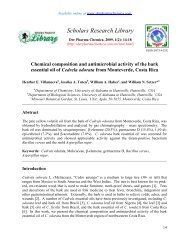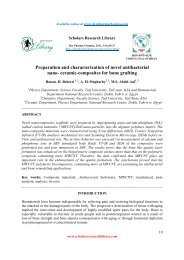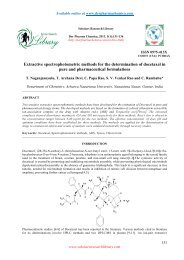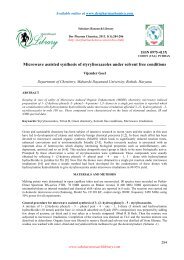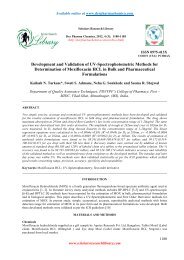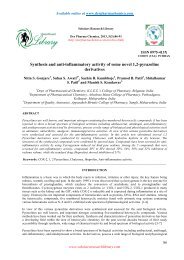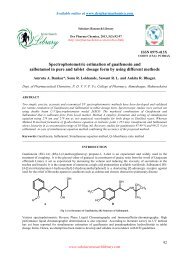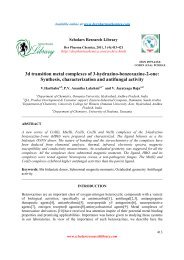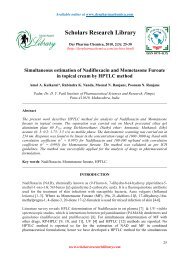Copper oxide nanoparticles-catalyzed direct N-alkylation of amines ...
Copper oxide nanoparticles-catalyzed direct N-alkylation of amines ...
Copper oxide nanoparticles-catalyzed direct N-alkylation of amines ...
Create successful ePaper yourself
Turn your PDF publications into a flip-book with our unique Google optimized e-Paper software.
Nagaraju Mittapelly et al Der Pharma Chemica, 2011: 3 (4):180-189_____________________________________________________________________________MATERIALS AND METHODSAll chemicals were purchased from Sigma-Aldrich and S.D Fine Chemicals, Pvt. Ltd. India andused as received. ACME silica gel (100–200 mesh) was used for column chromatography andthin-layer chromatography was performed on Merck-precoated silica gel 60-F 254 plates. All theother chemicals and solvents were obtained from commercial sources and purified using standardmethods. The IR spectra <strong>of</strong> all compounds were recorded on a Perkin-Elmer, Spectrum GX FTIRspectrometer. The IR values are reported in reciprocal centimeters (cm -1 ).The 1 H, 13 C NMR spectra were recorded on a Varian- 400 MHz, Bruker-Avance 300 MHzSpectrometer. Chemical shifts (δ) are reported in ppm, using TMS (δ =0) as an internal standardin CDCl 3 . ESI mass spectra were recorded on a Finnigan LCQ Advantagemax spectrometer. EImass spectra were recorded on a GC-MS QP2010 Plus (Shimadzu).Typical procedure for the N-<strong>alkylation</strong> <strong>of</strong> <strong>amines</strong> with alcohols: A mixture <strong>of</strong> amine (1mmol) alcohol (1.2 mmol), K 2 CO 3 (1.5 mmol) and CuO NPs (3 mol %) in toluene (3 mL) wasstirred at 110 o C temperature for 12 h. After completion <strong>of</strong> the reaction as indicated by TLC, thereaction mixture was centrifuged to separate the catalyst, the solid residue was washed withEtOAc to make the catalyst free <strong>of</strong> organic matter, and the reaction mixture was diluted withwater and then extracted with EtOAc. The combined organic layers were dried over anhydrousNa 2 SO 4 , concentrated in vacuo and purified by column chromatography on silica gel to affordthe pure product. All products were characterized by IR, 1 H NMR, 13 C NMR and massspectroscopic techniques.Spectroscopic data for the representative examples:1. Benzyl-phenyl-amine: (Table 2, entry 1): IR (neat): 3418, 2923, 1735, 1601, 1505,1252, 1069, 749 cm -1 . 1 H NMR (300 MHz, CDCl 3 ): δ 3.93 (brs, 1H), 4.31 (brs, 2H), 6.56 (d, 2H,J = 7.8 Hz), 6.65 (t, 1H, J = 7.2 Hz), 7.11 (d, 2H, J = 7.5 Hz), 7.21 – 7.35 (m, 5H). 13 C NMR (75MHz, CDCl 3 ): δ 48.26, 112.70, 117.5, 127.2, 127.4, 128.6, 129.2, 139.4, 148. ESI MS (m/z): 184(M + H).2. (4-Methoxy-benzyl)-phenyl-amine (Table 2, entry 2): Pale yellow oil; R f = 0.7 (inhexane/ethyl acetate 90:10). IR (neat): 749, 1032, 1175, 1244, 1507, 1604, 2835, 3415 cm -1 . 1 HNMR (300 MHz, CDCl 3 ): δ 3.78 (s, 3H), 3.83 (brs, 1H), 4.21 (s, 2H), 6.56 (d, 2H, J = 7.6 Hz),6.64 (t, 1H, J = 7.4 Hz), 6.81 (d, 2H, J = 8.5 Hz), 7.11 (m, 2H), 7.24 (d, 2H, J = 8.7 Hz). 13 CNMR (75 MHz, CDCl 3 ): δ 47.7, 55.2, 112.7, 113.9, 117.4, 128.7, 129.2, 131.3, 148.1, 158.8. ESIMS (m/z): 214 (M + H).3. (4-Methyl-benzyl)-phenyl-amine (Table 3, entry 3): IR (neat): 3418, 2920, 1603, 1507,1322, 1255, 1179, 749 cm -1 1 H NMR (300 MHz, CDCl 3 ): δ 2.34 (s, 3H), 3.86 (brs, 1H), 4.23 (s,2H), 6.54 (d, 2H, J = 7.6 Hz), 6.64 (t, 1H, J = 7.4 Hz), 7.06 – 7.14 (m, 4H), 7.20 (d, 2H, J = 7.9Hz). 13 C NMR (75 MHz, CDCl 3 ): δ 21.1, 48.1, 112.8, 117.5, 127.5, 129.2, 136.3, 136.8, 148.2.ESI MS (m/z): 198 (M + H).4. (4-Bromo-benzyl)-phenyl-amine (Table 2, entry 4): IR (neat): 3417, 1735, 1601, 1505,1231, 750 cm -1 1 H NMR (400 MHz, CDCl 3 ): δ 4.05 (brs, 1H), 4.29 (s, 2H), 6.60 (d, 2H, J = 8.7Hz), 6.72 (t, 1H, J = 7.3 Hz), 7.17 (m, 2H), 7.25 (d, 2H, J = 8.1 Hz), 7.46 (d, 2H, J = 8.1 Hz). 13 Cwww.scholarsresearchlibrary.com182



